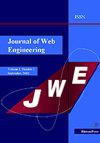Personalized User Models in a Real-World Edge Computing Environment: A Peer-to-Peer Federated Learning Framework
IF 1
4区 计算机科学
Q4 COMPUTER SCIENCE, SOFTWARE ENGINEERING
引用次数: 0
Abstract
As the number of IoT devices and the volume of data increase, distributed computing systems have become the primary deployment solution for large-scale Internet of Things (IoT) environments. Federated learning (FL) is a collaborative machine learning framework that allows for model training using data from all participants while protecting their privacy. However, traditional FL suffers from low computational and communication efficiency in large-scale hierarchical cloud-edge collaborative IoT systems. Additionally, due to heterogeneity issues, not all IoT devices necessarily benefit from the global model of traditional FL, but instead require the maintenance of personalized levels in the global training process. Therefore we extend FL into a horizontal peer-to-peer (P2P) structure and introduce our P2PFL framework: efficient peer-to-peer federated learning for users (EPFLU). EPFLU transitions the paradigms from vertical FL to a horizontal P2P structure from the user perspective and incorporates personalized enhancement techniques using private information. Through horizontal consensus information aggregation and private information supplementation, EPFLU solves the weakness of traditional FL that dilutes the characteristics of individual client data and leads to model deviation. This structural transformation also significantly alleviates the original communication issues. Additionally, EPFLU has a customized simulation evaluation framework, and uses the EUA dataset containing real-world edge server distribution, making it more suitable for real-world large-scale IoT. Within this framework, we design two extreme data distribution scenarios and conduct detailed experiments of EPFLU and selected baselines on the MNIST and CIFAR-10 datasets. The results demonstrate that the robust and adaptive EPFLU framework can consistently converge to optimal performance even under challenging data distribution scenarios. Compared with the traditional FL and selected P2PFL methods, EPFLU achieves communication time improvements of 39% and 16% respectively.现实世界边缘计算环境中的个性化用户模型:点对点联邦学习框架
随着物联网设备数量和数据量的增加,分布式计算系统已成为大规模物联网(IoT)环境的主要部署方案。联邦学习(FL)是一种协作式机器学习框架,允许使用来自所有参与者的数据进行模型训练,同时保护他们的隐私。然而,在大规模分层云边缘协作物联网系统中,传统的FL存在计算和通信效率低的问题。此外,由于异构问题,并非所有物联网设备都必须从传统FL的全球模型中受益,而是需要在全球培训过程中保持个性化水平。因此,我们将FL扩展为一个水平的点对点(P2P)结构,并引入我们的P2PFL框架:高效的用户点对点联邦学习(EPFLU)。EPFLU从用户的角度将范例从垂直FL转换为水平P2P结构,并结合使用私人信息的个性化增强技术。EPFLU通过横向共识信息聚合和私有信息补充,解决了传统FL淡化客户个体数据特征、导致模型偏差的缺点。这种结构上的转变也大大缓解了原有的沟通问题。此外,EPFLU具有定制的模拟评估框架,并使用包含真实边缘服务器分布的EUA数据集,使其更适合真实的大规模物联网。在此框架下,我们设计了两个极端的数据分布场景,并在MNIST和CIFAR-10数据集上进行了EPFLU和选定基线的详细实验。结果表明,即使在具有挑战性的数据分布场景下,鲁棒性和自适应的EPFLU框架也能始终收敛到最佳性能。与传统的FL和选定的P2PFL方法相比,EPFLU通信时间分别提高了39%和16%。
本文章由计算机程序翻译,如有差异,请以英文原文为准。
求助全文
约1分钟内获得全文
求助全文
来源期刊

Journal of Web Engineering
工程技术-计算机:理论方法
CiteScore
1.80
自引率
12.50%
发文量
62
审稿时长
9 months
期刊介绍:
The World Wide Web and its associated technologies have become a major implementation and delivery platform for a large variety of applications, ranging from simple institutional information Web sites to sophisticated supply-chain management systems, financial applications, e-government, distance learning, and entertainment, among others. Such applications, in addition to their intrinsic functionality, also exhibit the more complex behavior of distributed applications.
 求助内容:
求助内容: 应助结果提醒方式:
应助结果提醒方式:


